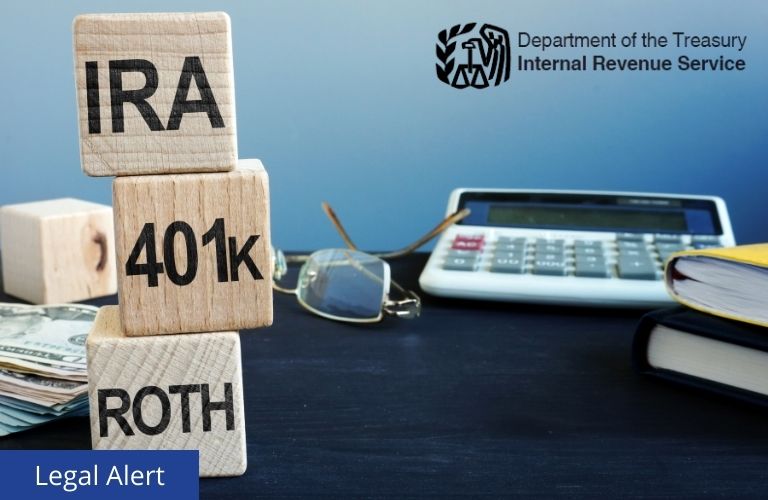
The SECURE 2.0 Act requires catch-up contributions (i.e., additional retirement plan contributions made by participants who are age 50 or older) made by higher-income participants to be designated as after-tax Roth contributions (the “Mandatory Roth Catch-up Requirement”). This new Mandatory Roth Catch-up Requirement was originally scheduled to take effect for taxable years beginning after December 31, 2023. However, the IRS granted an administrative transition period (through December 31, 2025) during which catch-up contributions made by higher-income participants were treated as satisfying the requirements even if they were not designated as Roth (see IRS Notice 2023-62). In January, the Department of the Treasury and the Internal Revenue Service issued proposed regulations (the “Proposed Regulations”) to provide much-awaited guidance for retirement plan sponsors on the Mandatory Roth Catch-up Requirements.
Higher-Income Affected Participants. Participants are “higher-income” if their prior-year FICA wages from the employer sponsoring the retirement plan exceeds $145,000 (indexed after 2024) (the “Affected Participants”). Under the Proposed Regulations, the “employer” is the participant’s common law employer sponsoring the retirement plan. If there are multiple employers in a controlled group participating in a single 401(k) plan, each of the participating employers would be treated as a separate employer sponsoring the plan. If a participant earned FICA wages at one of these employers and transferred mid-year to another employer, the FICA wages would be treated separately for determining whether the limit was met.
The Mandatory Roth Catch-up Requirement does not apply to any participant who does not have FICA wages for the preceding calendar year from the employer sponsoring the plan, including self-employed individuals. In addition, a participant’s FICA wage threshold is not prorated for the first year of employment.
Deemed Roth Catch-Up Contributions. A plan may provide that an Affected Participant is deemed to have irrevocably designated any catch-up contributions as designated Roth contributions; provided, however, that the Affected Participant has the opportunity to make a new election that is different than the deemed election. For example, a plan would need to permit an Affected Participant to elect to cease making additional elective deferrals rather than to have them treated as Roth.
Requirements for a Roth Feature. A plan sponsor that does not currently have a Roth feature in its retirement plan is not required to add a Roth feature. However, if a plan does not have a Roth feature, then Affected Participants will be unable to make catch-up contributions.
Ability to Still Make Pre-Tax Catch-Up Contributions. The Proposed Regulations confirm that plans cannot comply with the new rule by simply requiring all participants to make catch-up contributions on an after-tax Roth basis. Participants earning $145,000 or less (indexed) must still be allowed to make pre-tax catch-up contributions.
Corrections. If an Affected Participant makes a pre-tax catch-up contribution, the plan will fail to be qualified unless the failure is corrected. A failure may be corrected by distributing catch-up contributions that should have been Roth from the plan in accordance with correction methods currently set forth in the IRS’ Employee Plans Compliance Resolution System (“EPCRS”) for excess annual additions. However, the Proposed Regulations set forth two new methods that allow an Affected Participant’s pre-tax catch-up contribution to be corrected by either a transfer or an in-plan Roth rollover:
- Transfer. The catch-up contribution (adjusted for allocable gain or loss) could be transferred from the Affected Participant’s pre-tax account to his or her Roth account and the amount (not adjusted for allocable gain or loss) reported as a designated Roth contribution on the Affected Participant’s Form W-2 for the year of the deferral (i.e., reporting it as if it had been correctly made as Roth). This method, however, is not available if the Form W-2 has already been filed or furnished.
- In-plan Roth rollover. Under this method, a plan would directly roll over the catch-up deferral (adjusted for allocable gain or loss) from the Affected Participant’s pre-tax account to his or her designated Roth account and report the amount of the in-plan Roth rollover on Form 1099-R for the year of rollover. The contribution (adjusted for allocable gain or loss) would be includible in the participant’s gross income for the year of the rollover.
Correction methods are only available if the plan has reasonable administrative procedures in place that are designed to comply with the new Mandatory Roth Catch-up Requirements, including that elective deferrals will be automatically converted to Roth for Affected Participants when they reach the 415 or 402(g) limit during the year. A plan sponsor can elect to use either of the two new methods, but it must apply the same correction method for all participants and the plan must provide for Deemed Roth Catch-up Contributions.
Next Steps. Plan Sponsors should ensure that their payroll provider will be able to readily identify Affected Participants for 2026. In addition, if plan sponsors do not currently have a Roth feature in their retirement plan, they will need to amend their plan to allow for Roth contributions—otherwise, their Affected Participants will not be able to make catch-up contributions.
If a Plan Sponsor wants the ability to utilize the new correction methods, then it should (1) confirm with its recordkeeper that catch-up contributions will be treated as Deemed Roth Catch-ups for Affected Participants and that elective deferrals will be automatically converted to Roth if an Affected Participant reaches the elective deferral limits; (2) ensure that its plan allows for in-plan Roth rollovers; and (3) has reasonable administrative procedures for compliance with the new Mandatory Roth Catch-up Requirements.
If you have questions on this topic, contact your SGR Employee Benefits and Executive Compensation counsel.

